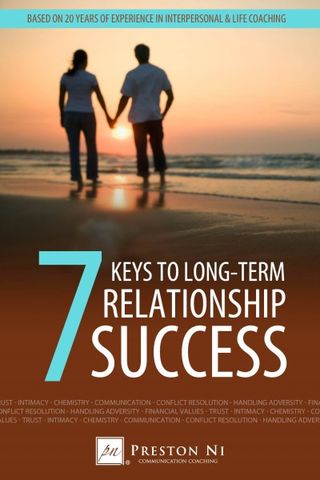Relationships
How to Enhance Closeness in Your Relationship
Are you and your partner compatible in the dimensions of intimacy?
Posted September 3, 2012 Reviewed by Ekua Hagan

Would you like to increase connectedness with your partner? In what ways can intimacy be understood and improved? Authors Ronald Adler and Russell Proctor II identified four ways with which we can feel closely connected with someone. Although these elements apply to many types of relationships, in this article we'll focus on closeness between romantic partners. Below are four dimensions of intimacy, based on my book: "7 Keys to Long-Term Relationship Success".
Physical – Hugging, kissing, caressing, cuddling, holding, and other forms of physical affection. Physical intimacy certainly includes sex, but doesn’t have to. As long as other aspects of the relationship remain sound, physical intimacy between partners can often last a lifetime, even if sexual potency diminishes due factors such as health, age, and stress.
“Millions and millions of years would still not give me half enough time to describe that tiny instant of all eternity when you put your arms around me and I put my arms around you.”
– Jacques Prévert
Emotional – The ability to effectively express and validate tender, loving emotions, in a manner that's nourishing and constructive, and being able to respond affirmatively when the other person does the same. For example: "How are you doing?" "How are you feeling?" "I love you," "I appreciate you," "I like it when we talk like this," "I'm glad we're spending this time together," "you're very important in my life," "I'm sorry."
A person's "heart withers if it does not answer another heart."
– P. Buck
Intellectual – Can brains be attractive and sexy? Absolutely! Especially for those who feel a sense of kinship when they engage in discussion or endeavor with a partner whom they feel is an intellectual equal.
“The marriage was a meeting of hearts and minds both. Madame Lavoisier had an incisive intellect and soon was working productively alongside her husband (chemist Antoine Lavoisier)…they managed to put in five hours of science on most days – two in the early morning and three in the evening – as well as the whole of Sunday, which they call their day of happiness."
– Bill Bryson
Shared Activities – Interactions that build a positive memory bank of shared experiences. Examples include playing, cooking, dancing, exercising, art making, traveling, worshipping, and problem solving together. In this dimension, it's not just the activity that matters, but whether two people are able to bond while interacting with one another.
“When partners spend time together, they can develop unique ways of relating that transform the relationship from an impersonal one to an interpersonal one.”
– Ronald Adler and Russell Proctor II
Here’s a quick exercise to check you and your partner's compatibility in intimacy. List the four dimensions as follows:
__
Partner A Partner B
Physical
Emotional
Intellectual
Shared Activities
__
Next to each dimension, rank whether this is a “must” have, “should” have, or “could” have for you in your romantic relationship. “Must” means this dimension is crucial for you, without which you would feel the relationship amiss. “Should” means this dimension is good to have, but you don’t necessarily have to experience it every day. “Could” means this dimension is relatively unimportant - you can take it or leave it.
After answering for yourself, either ask your partner to rank, or on your own put down how you think your partner would prioritize. Below is one example of some possible combinations:
__
Partner A Partner B
Physical Intimacy Must Must (Excellent Comp.)
Emotional Intimacy Must Should (Good Compatibility)
Intellectual Intimacy Should Should (Good Compatibility)
Shared Activities Could Must (Poor Compatibility)
__
The more “must-must” and “must-should” combinations between you and your partner, the greater the possibility of an intimate relationship.
If there is one or more "must-could" combination, dialogue with your significant other to see if the "could" can be transitioned to a "should." For example, a partner who's not very physically affectionate can learn to give a hug a day, or a spouse who's emotionally reserved can learn to share important feelings when necessary. While some expressions of intimacy may come to us more naturally than others, we're all capable of learning and growing in new directions.
When left unreconciled, the “must-could” combination, even if manageable in the short term (perhaps due to the intensity of sexual attraction and/or relative newness of relationship), may in the long run become problematic. Fewer experiences in a romantic relationship feel more lonesome than an unmet “must” need for intimacy.
Since relationships are not static, a couple may evolve in the dimensions of intimacy. Even similar intimacy preferences need flexibility to mesh and jell. Understanding one another’s priorities, and connecting in ways that are important to both partners help ensure long-term relational success.

For more tips on relationship success, see my books (click on titles): "7 Keys to Long-Term Relationship Success" and "How to Communicate Effectively and Handle Difficult People".
© 2012 by Preston C. Ni. All rights reserved worldwide. Copyright violation may subject the violator to legal prosecution.




